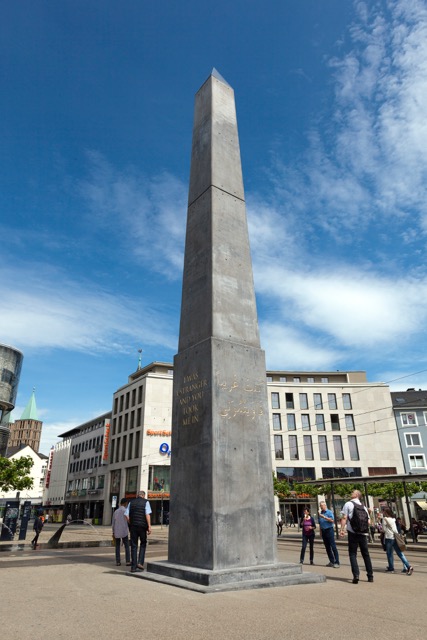Every five years the sedate city of Kassel, Germany, launches an art expo that attempts to capture the zeitgeist of our times, documenta. This 14th edition was an ambitious one, costing over $36 million, with one part opening in Athens, Greece, in April (ending July 16), and the other part starting in Kassel in June and ending September 17. The Kassel expo presents work by some 160 international artists, with shows and installations scattered about 35 sites—exhibition galleries, public squares, the main train station and movie theaters.
While the theme of documenta was supposedly “Learning from Athens,” artistic director Adam Szymczyk and his team tuned into hot-button current issues, such as immigration, free speech, environmentalism, colonialism and pop culture. Frankly, it was a matter of too much of everything, a dizzying Art Tower of Babel. Far better had the curators exercised more curatorial choice. If they had chosen 40 or 50 artists, say, and shown more work by each artist, the experience could have been more impactful and satisfying.

Marta Minujín, The Parthenon of Books, 2017, steel, books, and plastic sheeting , Friedrichsplatz, Kassel, documenta 14, photo: Roman März
Two of my favorite works incorporated books—yes, those quaint old things. Sited in Friedrichsplatz, the main public square of Kassel, Marta Minujín’s The Parthenon of Books, has become the emblem of documenta 14. It’s a large, impressive steel structure echoing the form and dimensions of the Parthenon in Athens, the legendary birthplace of Western civilization, and is covered with books suspended in plastic sheeting, books that have been banned (and donated by the public). It makes fascinating browsing as you walk around. You’ll find everything from Vladimir Nabokov’s Lolita to—surprise!—J.K. Rowling’s Harry Potter and the Sorcerer’s Stone. In recreating her 1983 artwork, the Argentinian artist comments on the persistence of censorship.
Meanwhile, in an indoor venue, Maria Eichhorn’s installation of Unlawfully Acquired Books from Jewish Ownership reflects her ongoing interest in examining institutions—in this case, the Nazi government which appropriated whole libraries (and art collections) from its Jewish population. The German artist discovered that some of these books ended up in the Berlin Central and City State Library, and has placed a selection into a very tall bookcase, accompanied by photographs and documents about the thefts. The project includes a website where the public may report what they know of “orphaned property.”

Maria Eichhorn, Unlawfully acquired books from Jewish ownership, installation view, Neue Galerie, Kassel, documenta 14, © Maria Eichhorn/VG Bild-Kunst, Bonn 2017, photo: Mathias Völzke
Several of the most interesting pieces are outdoors or part of the “Glass Pavilions,” free for all see. Monument for Strangers and Refugees by Nigerian artist Olu Oguibe is a 52-foot concrete obelisk in Konigsplatz, a plaza in major shopping area. Around the lower section is a phrase from the New Testament in four languages—Arabic, English, German and Turkish—“I was a stranger and you took me in.” It is a nod to the immigration crisis, and perhaps especially to the German government’s decision to take in over a million refugees since 2015.

Olu Oguibe, Das Fremdlinge und Flüchtlinge Monument (Monument for strangers and refugees), 2017, concrete, Königsplatz, Kassel, documenta 14, photo: Michael Nast
The “Glass Pavilions” storefronts along a once-prosperous shopping avenue are a particularly innovative showcase, and free to enter. In one former shop, Mounira Al Solh has recreated the simple Beirut bakery her father ran in the mid-1980s in an installation called Nassib’s Bakery. It provided food in a time of scarcity and was highly popular with locals until bombed and burned to the ground. (She retells the story in nearby text.) Downstairs she has filled several rooms with ink sketches of Middle Eastern and North African migrants she has met in Kassel and Athens, the diaspora of the dispossessed.

Mounira Al Solh, works from I Strongly Believe in Our Right to Be Frivolous, 2012–17, graphite on paper, installation view, Glass Pavilions on Kurt-Schumacher-Strasse, Kassel, documenta 14, photo: Fred Dott
Incidentally, despite all this denunciation of censorship and oppression, our guide during a walking tour of documenta was censored. He was providing us some background in the lobby of the Fridericianum building when a young man from documenta came up and told him he couldn’t be acting as a guide since he wasn’t an official, designated guide. “Ah, so you have to ask me questions,” our guide, who had seen many a Documenta, said to us, “and I will respond.” And we did, and he did. So much for freedom of speech!


